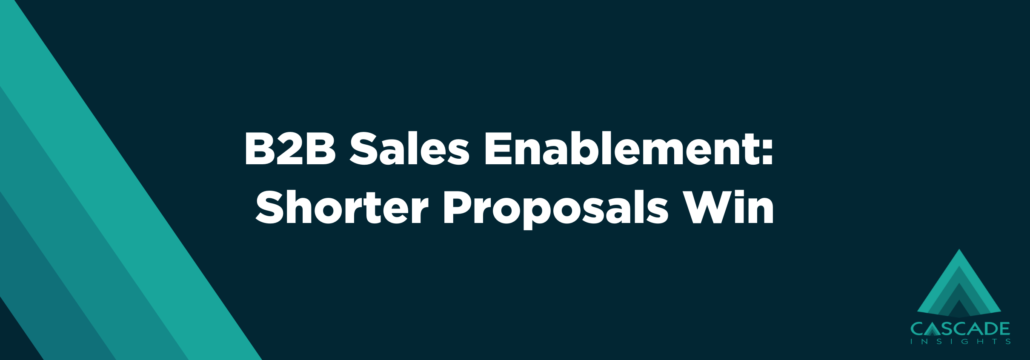Proposal writing is somewhat counter-intuitive. Many sellers seek to impress with doctorate thesis style proposals. But, the truth is, the best proposals are shorter rather than longer. Smart B2B sales enablement strategies and tactics focus on the customer instead of the firm. Proposals also need to answer buyers’ unasked questions.
Unfortunately, the vast bulk of proposals I’ve seen over my life fail to meet any of these criteria. Here are some of the frequent errors I’ve seen with B2B tech sector sales enablement strategies and tactics and how to correct them.
Wrong Choice #1: A Long Proposal
A great many B2B sellers think that the more they write, the more likely it is they will win a deal. Typically, this is the same seller who has the “gift for gab.” Lacking an ability to filter their verbal communication, these sellers struggle to keep their writing concise and to the point.
A seller who is unable to stop typing will develop a proposal with the following flaws:
Every slide is filled top to bottom with text with little white space to be found.
No short sentences.
Too many “ands” contributing to an impression of lack of focus. For example: “pick us because of this, and this, and this.”
Wrong Choice #2: Let Me Tell You About Us
Many sellers believe that a potential customer needs a great deal of information about their product or solution. Not true.
A proposal that gets lost in the swamp of details will be at best skimmed, at worst, ignored.
Customers want to hear about themselves. Their problems, their jobs-to-be-done, the business outcomes they need to achieve, etc.
Wrong Choice #3: Only Answering the Obvious
Many proposals appear to be produced by an AI despite being written by a human. You can spot these types of proposals by how robotically they shift from one customer specification to the next, mechanically answering each question in turn.
B2B sellers fall into this bad habit because it feels safe. If you answer all their questions, how can they fail to buy?
Young padawan, this is not where security lies.
These questions are only the table stakes. In fact, these are the questions they are asking of everyone. Stopping at just answering the obvious questions merely puts you on the same level as everyone else. That’s not going to lead to a win.
Right Choice #1: Shorter is Better
Blaise Pascal once said, “I would have written a shorter letter, but I did not have the time.” How true this is.
A great proposal is short. Think of powerful quotes and proverbs. What makes them powerful? They say a lot in a little.
B2B Sales Challenge: Take your current proposal and try to write it with half the number of pages or slides. You and your prospects will be glad you did. Just remember, it’s going to take more time to do so, not less.
Right Choice #2: It’s About Them, Not You
The right proposal gets the client’s context right, on every slide, in every paragraph.
That’s not to say you need to use heady technical jargon. Use simple language that your prospect can easily follow.
Doing this is hard. As a B2B seller, you’ll be tempted to add a lot more than you need. You don’t need to mention when the client was founded and all their past successes. Imagine you are writing a haiku more than Lord of the Rings and you’ll be in the right frame of mind.
If a potential client doesn’t feel you understand where they are today and where they want to go, why would they pick you?
B2B Sales Challenge: Try to explain your client’s entire need in two sentences. You’ll be glad you did when they thank you for nailing it.
Right Choice #3: Answer the Unasked
A great proposal answers the unasked questions. Or, better yet, answers the question behind the questions.
Fairly frequently, potential accounts will bury a seller in a barrage of tactical questions. Usually, the B2B seller feels compelled to answer each question in triplicate.
What’s more important than answering those questions? Figuring out what’s motivating those questions. Typically, a barrage of tactical questions about your solution is sheltering a single big question. This question might be about your capabilities, trust in you as a vendor, a critical concern about your process, quality control, or something else. Invariably, this question is not listed in the RFP, nor is it surfaced without significant prompting from the seller.
The best way to understand why this is so is to look at the B2B Elements of Value. The B2B Elements of Value is a great tool that shows how buyers and sellers tend to communicate about tactical attributes of a solution first (features, capabilities, price, etc.) when what’s really driving the sale are factors like trust, self-actualization of the buyer, etc.
B2B Sales Challenge: Instead of just answering all the basic questions, find out what they really want to know.
Wise Words
In 1946, Eleanor Roosevelt was elected to a UN committee to develop a universal charter of Human Rights. The Ken Burns series, “The Roosevelts: An Intimate History,” describes her relationship with fellow committee members as follows: “She was as tough as she was tactful. And she drove her fellow delegates so hard, that one felt called upon to remind her that they had human rights too.” Eleanor Roosevelt said in response, “If they wanted shorter days, they should make shorter speeches.”
This should be the goal of every B2B seller too. Shorter, more concise, and better thought-out proposals. Sellers who will do this will have shorter days and more sales.
If you want to learn how we can help your sales team write (and sell) better, check out our B2B Sales Enablement Services.

